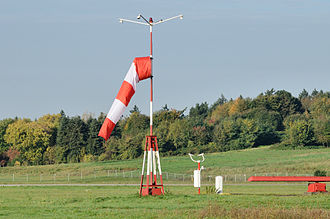Windsock

A windsock is a conical textile tube that resembles a giant sock. Windsocks can be used as a basic guide to wind direction and speed, or as decoration.
Uses[]
Windsocks are used to tell wind speed and the direction of the wind. Windsocks typically are used at airports to indicate the direction and strength of the wind to pilots and at chemical plants where there is risk of gaseous leakage. They are sometimes located alongside highways at windy locations.
At many airports, windsocks are lit at night, either by floodlights on top surrounding it or with one mounted on the pole shining inside it.[1]
Function[]
Wind direction is the direction in which the windsock is pointing (note that wind directions are conventionally specified as being the compass point from which the wind originates; so a windsock pointing due north indicates a southerly wind). Wind speed is indicated by the windsock's angle relative to the mounting pole; in low winds, the windsock droops; in high winds it flies horizontally.
Alternating stripes of high visibility orange and white were initially used to help to estimate the speed of wind. Each stripe adds up 3 knots to the estimated wind speed. However, some circle frames mountings cause windsocks to be held open at one end, indicating a velocity of 3 knots, even though anemometers would show no wind speed. A fully extended windsock suggests a wind speed of 15 knots (28 km/h; 17 mph) or greater.[2]
Standards[]
Per FAA standards, a properly-functioning windsock will orient itself to a breeze of at least 3 knots (5.6 km/h; 3.5 mph) and will be fully extended by a wind of 15 knots (28 km/h; 17 mph).[1]
Per Transport Canada standards a 15 knots (28 km/h; 17 mph) wind will fully extend the wind sock, a 10 knots (19 km/h; 12 mph) wind will cause the wind sock to be 5° below the horizontal, a 6 knots (11 km/h; 6.9 mph) wind will cause the wind sock to be 30° below the horizontal.[3]
In ICAO standards a truncated cone shaped windsock at least 3.6 m long and 0.9 m in diameter at the large end is specified. It should be visible and understandable from a height of 300 m and ideally be of a single colour. If it is necessary to use two colours they should ideally be orange and white arranged in five alternating bands, the first and last should be darker in colour. In wind speeds of 3 knots (5.6 km/h; 3.5 mph) or more they must indicate wind direction to within ±5°.[4]
See also[]
References[]
| Wikimedia Commons has media related to Windsocks. |
- ^ Jump up to: a b ACP 125(F), FAA Advisory Circular 150/5345-27D (PDF 447KB) (PDF), Federal Aviation Administration, 2 June 2004, retrieved 2017-01-07
- ^ "Windsocks facts". Piggotts Flags And Branding. Archived from the original on 2017-03-01. Retrieved 2017-02-28.
- ^ Transport Canada Aeronautical Information Manual (TC AIM) - Aerodromes (AGA) §5.9 Wind Direction Indicators, Transport Canada, 25 March 2021, retrieved 2021-04-04
- ^ Annex 14 to the Convention on International Civil Aviation - Aerodromes, Volume 1 §5.1.1 Wind Direction Indicator, International Civil Aviation Organization, July 2013
- Meteorological instrumentation and equipment
- Socks
- Aviation stubs
- Atmospheric science stubs